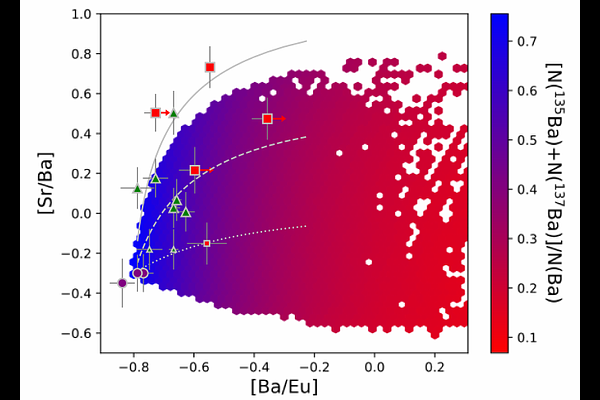Unlocking the mystery of Sr synthesis in the early Galaxy through analysis of barium isotopes in very metal-poor stars

Unlocking the mystery of Sr synthesis in the early Galaxy through analysis of barium isotopes in very metal-poor stars
T. M. Sitnova, L. Lombardo, L. I. Mashonkina, F. Rizzuti, G. Cescutti, C. J. Hansen, P. Bonifacio, E. Caffau, A. Koch-Hansen, G. Meynet, R. Fernandes de Melo
AbstractWe determine the contributions of the rapid (r) and slow (s) neutron capture processes to the Ba isotope mixture, along with Ba, Eu, and Sr NLTE abundances, in a sample of very metal-poor stars. The selected stars formed before the contribution from the main s-process in low- and intermediate-mass stars became significant. Some of our sample stars are enhanced in Sr, with [Sr/Ba] reaching up to 0.7. These stars gained their high Sr abundance from a poorly understood process, which may appear to be a weak s-process or a weak r-process. Our aim is to uncover the nature of this additional Sr source. The abundances derived from the resonance Ba II lines are influenced by the adopted Ba isotope mixture. We compute Ba isotope mixtures corresponding to different r- to s-process contributions and determine the corresponding abundances from the Ba II resonance lines in each sample star. Additionally, we determine Ba abundances from weak subordinate Ba II lines, which are unaffected by the adopted Ba isotope mixture. We then compare the Ba abundances derived from the subordinate lines with those from the Ba II resonance lines. We find a higher s-process contribution to Ba isotopes in stars with greater [Sr/Eu] and [Sr/Ba] overabundances, suggesting that the additional Sr synthesis was due to the early s-process occurring in massive stars. We estimate the [Sr/Ba] ratio produced by the early s-process and obtain [Sr/Ba]_earlyS = 1.1 +- 0.2. Regarding the potential synthesis of Sr and Ba in the i-process in massive stars, our results argue that there was no detectable contribution from this process within the error bars in our sample stars. In the early Galaxy, before significant main s-process enrichment, barium and strontium were produced primarily by the main r-process and the early s-process, which occurred in rapidly rotating massive stars.